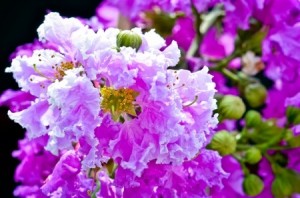
Summer beauty of the crapemyrtle flower
Crapemyrtles are one of our loveliest non-native species. They produce a summer of showy flowers, an autumn of bright fall colors, and a winter of eye-pleasing intricate bark patterns. The tree’s unusual natural architecture adds visual diversity to our local landscapes. Unfortunately, many crapemyrtles in Hampton Roads never display that superior and beautiful form. The poor trees are hacked and butchered by any self-proclaimed pro who will physically assault the hapless plant for profit—effectively robbing the tree’s owner of money and aesthetic value.
Do Yourself a Favor – Hire a Certified Pro to Prune Your Plants
For pruning trees, you can find Certified Arborists at the International Society of Arboriculture’s website. Alternatively, you can call us. Pruning crapemyrtles correctly isn’t rocket science, but it requires a basic understanding of tree physiology and the skill to visualize how the plant will respond to the pruning. It’s both an art and a science which requires practice, patience and experience to perfect. Our employees are formally trained in pruning crapemyrtles correctly.
Crapemyrtle Selection – Choose an Appropriate Sized Cultivar
After some initial structural training, crapemyrtles need little, if any pruning at all, provided you select the right cultivar for the growing space available. Most often when we prune any tree, we are pruning it not for the tree’s benefit, but for the benefit of the homeowner (i.e. raising the crown for a view or reducing the crown for clearance from a roof). Proper selection will eliminate unnecessary pruning. When deciding which plant to install, in addition to considering many other factors like flower color and hardiness, be sure to consider the mature size of the plant. This will minimize the need for maintenance pruning in the future and your tree’s natural architecture and beauty will remain.
Maintaining Crapemyrtles Which Are Too Large
If you have a large crapemyrtle like the white-flowered ‘Natchez’ or the pink-flowered ‘Choctaw’ planted in a small space, sometimes the best solution is to remove it and install a more appropriate mature-sized specimen. Topping the tree is not a good option. No competent arborist will recommend topping a crapemyrtle or any other tree.
Topping will significantly increase stem decay, ruin the tree’s architecture, and cause poorly attached epicormic branches to develop profusely. Basal suckers will develop and annual maintenance costs will increase. Flowering will be delayed and blooming season will be shortened.
If the crown needs to be reduced, it is critical to respect the internal physiology of the plant and make the pruning cuts correctly. Cuts made to remove entire branches should be made outside the branch collar to assist the tree in compartmentalizing the wound. Trees do not heal, they seal. If you cut carelessly and damage the branch barrier zone inside the branch collar, you are unnecessarily exposing your tree to pathogens that will infect and damage your tree.
Any heading cuts should be made back to a lateral stem at least one-third the diameter of the branch being removed. If practical, it’s preferable to cut back to an outward facing bud.
Why Do Many Landscaping and Tree Services Top Crapemyrtles?
Because topping takes the least amount of time to complete. When consumers insist on the lowest price and simultaneously lack understanding of the long-term negative effects of improper pruning, self-proclaimed pros will continue to disfigure our crapemyrtles. The most cost-effective approach to maintaining your crapemyrtles is to educate yourself and hire an expert who will have your landscape’s long-term interest in mind when recommending and performing work.
